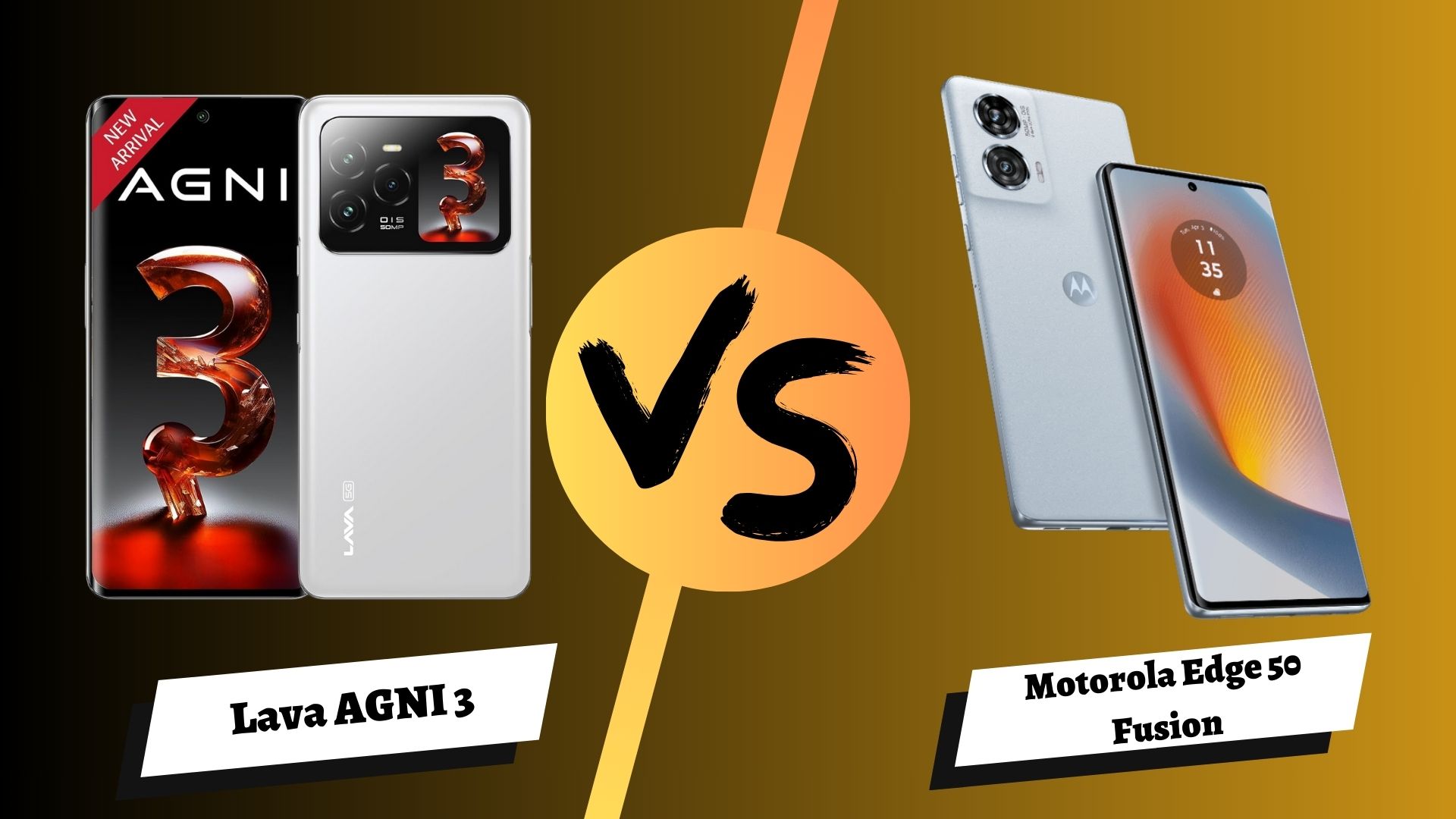
The mid-range smartphone segment is fiercely competitive, and two devices vying for your attention are the Lava Agni 3 and the Motorola Edge 50 Fusion. Both offer a compelling blend of features, performance, and design, making the decision a tough one. To help you navigate this choice, we’ll take a closer look at the strengths and weaknesses of each device, examining their design nuances, performance capabilities, camera prowess, software features, and more.
Design and Display: Lava Agni 3 vs Motorola Edge 50 Fusion
The Lava Agni 3 and the Motorola Edge 50 Fusion present distinct design philosophies. The Agni 3, with its dimensions of 163.7 x 75.5 x 8.8 mm and a weight of 212g, is slightly larger and heavier than the Edge 50 Fusion, which measures 161.9 x 73.1 x 7.9 mm and weighs 174.9g. This difference in size and weight might influence your comfort and handling preference.
While both phones feature a glass front, the Agni 3 opts for a silicone polymer back with an eco-leather option, coupled with a plastic frame. In contrast, the Edge 50 Fusion boasts a more premium build with Gorilla Glass 5 protection, enhancing its durability and resistance to scratches.
Turning to the displays, both phones offer vibrant visuals and smooth user experiences. The Agni 3 boasts a 6.78-inch AMOLED display with a 120Hz refresh rate and 1200 nits peak brightness, ensuring fluid animations and excellent outdoor visibility. The Edge 50 Fusion counters with a slightly smaller 6.7-inch P-OLED display, but with a higher 144Hz refresh rate in its international version and an even brighter 1600 nits peak brightness. This higher refresh rate could translate to a more responsive gaming experience.
A unique feature of the Agni 3 is its secondary display on the back. This innovative addition allows for quick notifications, time checks, and even personalized displays, adding a layer of functionality not found in the Edge 50 Fusion.
Performance and Hardware: Lava Agni 3 vs Motorola Edge 50 Fusion
Under the hood, the Lava Agni 3 is powered by the Mediatek Dimensity 7300X processor, a 4nm chipset known for its balance of performance and power efficiency. The Motorola Edge 50 Fusion, on the other hand, utilizes the Qualcomm Snapdragon 7s Gen 2 processor in its international version, also a 4nm chipset that promises robust performance. However, the LATAM version of the Edge 50 Fusion uses the Snapdragon 6 Gen 1, which might offer slightly less processing power.
Both phones offer ample RAM and storage options to cater to varying needs. The Agni 3 comes with 8GB of RAM and either 128GB or 256GB of storage. The Edge 50 Fusion provides more flexibility with 8GB or 12GB RAM configurations and storage options ranging from 128GB to 512GB. This wider range of configurations allows you to tailor the phone to your specific usage patterns.
In terms of battery life, both devices pack a substantial 5000 mAh battery, ensuring you can comfortably get through a full day of usage. The Edge 50 Fusion edges out the Agni 3 slightly with its 68W wired charging compared to the Agni 3’s 66W wired charging, potentially reducing the time spent tethered to a charger.
Camera System: Lava Agni 3 vs Motorola Edge 50 Fusion
The camera systems on both phones are designed to capture memorable moments, but with different approaches. The Agni 3 boasts a triple rear camera setup comprising a 50MP primary sensor with PDAF and OIS for sharp and stable images, an 8MP telephoto lens with 3x optical zoom for capturing distant subjects, and an 8MP ultrawide lens for expansive shots.
The Edge 50 Fusion simplifies its camera system with a dual rear camera setup. It features a 50MP primary sensor with dual pixel PDAF and OIS for improved focus and stability, and a 13MP ultrawide lens. While lacking a dedicated telephoto lens, the Edge 50 Fusion’s primary sensor benefits from dual pixel technology for potentially enhanced image quality.
For selfies, the Edge 50 Fusion takes the lead with its 32MP front-facing camera, offering higher resolution and potentially more detailed self-portraits compared to the Agni 3’s 16MP selfie shooter.
Software and Additional Features: Lava Agni 3 vs Motorola Edge 50 Fusion
Both the Lava Agni 3 and the Motorola Edge 50 Fusion run on the latest Android 14 operating system, providing a clean and modern user experience. Both manufacturers also promise three major Android updates, ensuring your phone stays up-to-date with the latest features and security enhancements.
In terms of connectivity, both devices offer dual SIM support, Wi-Fi 6, Bluetooth (5.4 on the Agni 3 and 5.2 on the Edge 50 Fusion), and USB Type-C connectivity. The Edge 50 Fusion gains an edge with its inclusion of NFC, enabling convenient contactless payments and data transfer.
Durability is another area where the phones differ. The Agni 3 carries an IP64 rating, signifying its resistance to dust and water splashes. The Edge 50 Fusion boasts a higher IP68 rating, meaning it can withstand submersion in water up to a certain depth, offering greater peace of mind in challenging environments.
The Motorola Edge 50 Fusion also supports Ready For, a platform that extends the phone’s functionality to larger screens, allowing for desktop-like experiences, gaming on a bigger display, and enhanced video calls.
Pricing: Lava Agni 3 vs Motorola Edge 50 Fusion
- Lava Agni 3: Starts at ₹20,999 – Best Buy Link!
- Motorola Edge 50 Fusion ₹20,999– Best Buy Link!
The Verdict: Choosing Your Champion
The Lava Agni 3 and the Motorola Edge 50 Fusion are both strong contenders in the mid-range smartphone arena, each with its own set of strengths and weaknesses. The Agni 3 stands out with its unique rear display, telephoto lens, and competitive pricing. The Edge 50 Fusion counters with a more premium build, potentially better performance (depending on the region), a superior front-facing camera, NFC functionality, and a higher IP rating.
Ultimately, the best choice depends on your individual needs and priorities. If you value a unique design, a telephoto lens, and affordability, the Agni 3 might be the better option. If you prioritize a premium build, overall performance, a strong selfie camera, and added features like NFC and Ready For, the Edge 50 Fusion could be the more suitable choice.


















